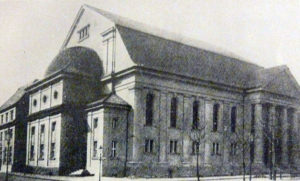
This place was one of the most important in the Jewish history of Moabit. In the first half of the 20th century, thousands of Jews lived here in the surrounding district. Three synagogues were within walking distance: First, the orthodox Adass Jisroel community in Siegmunds Hof, a few hundred yards from here. Second, the Association of Synagogues in Moabit and Hansabezirk in Flensburger Strasse, and finally a large synagogue here.
It was designed by the architect Johann Hoeniger, was inaugurated in April 1914, and had just over 2,100 seats, making it one of the largest in Berlin. One part of the synagogue complex was only completed in 1919, presumably due to the First World War. The synagogue was seen as liberal, since most of the Jews in the area belonged to this movement.
The main entrance on Levetzowstrasse was flanked by four massive pillars. These doors were only opened on special days, however. Usually, community members would use the entrance in Jagowstrasse, which also led to both courtyards in the synagogue.
As is usual in almost all Jewish places of worship, the congregation was divided by sex during prayer: In the large hall, men prayed downstairs and women upstairs in the gallery. The associated weekday synagogue in Jagowstrasse did not enforce separation by sex quite so strictly.
The Levetzowstrasse synagogue quickly became the hub for the Jewish population from Moabit and Hansaviertel. There was the community centre, a religious school, and some community housing.
From the very start, its head was Rabbi Dr Julius Lewkowitz. He remained faithful to the community until his deportation in 1943. He and his wife Selma lived in a community apartment in Jagowstrasse 38. The couple had several Jewish lodgers, all of whom were deported, too. Julius and Selma Lewkowitz were murdered in Auschwitz. You can find two Stolpersteine to their memory in Jagowstrasse. The synagogue survived the 1938 November Pogrom with some fire damage to the frontage and some destruction in the interior. By contrast with many other Jewish facilities, it could be used as a place of worship again by spring 1939 and remained in operation until 1941.
« Their Last Journey – an audio walk
The synagogue as collection camp »


